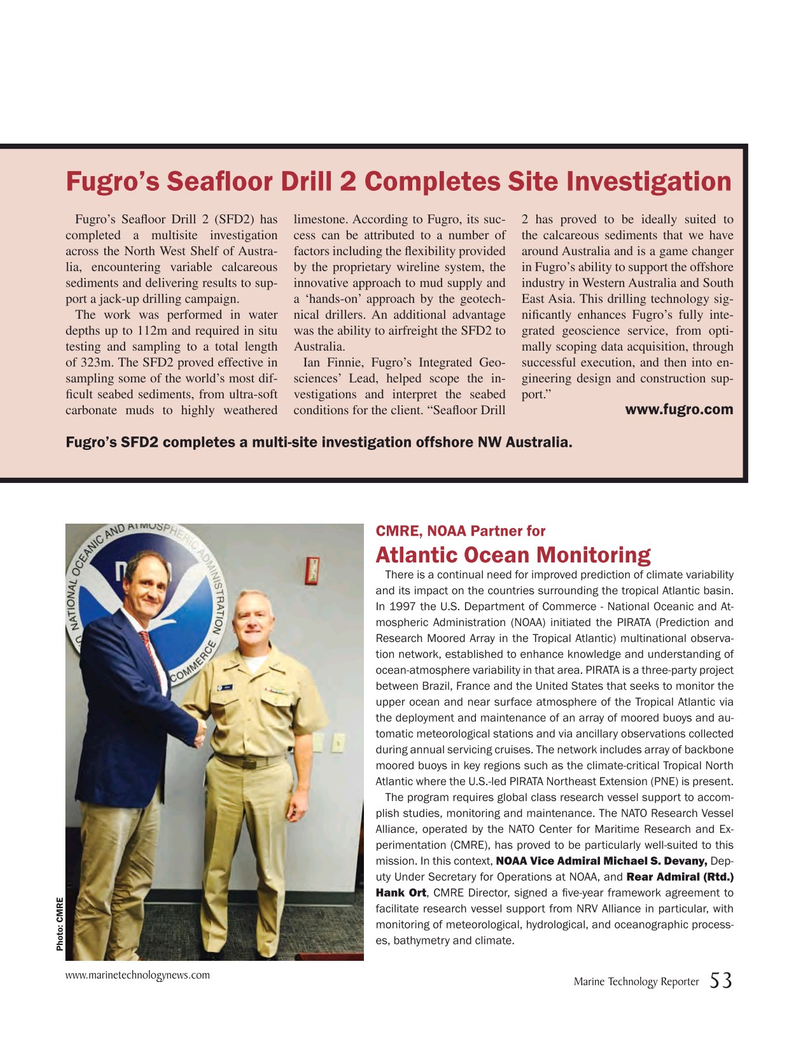
Page 53: of Marine Technology Magazine (January 2016)
Underwater Vehicle Annual: ROV, AUV, and UUVs
Read this page in Pdf, Flash or Html5 edition of January 2016 Marine Technology Magazine
Fugro’s Sea? oor Drill 2 Completes Site Investigation
Fugro’s Sea? oor Drill 2 (SFD2) has limestone. According to Fugro, its suc- 2 has proved to be ideally suited to completed a multisite investigation cess can be attributed to a number of the calcareous sediments that we have across the North West Shelf of Austra- factors including the ? exibility provided around Australia and is a game changer lia, encountering variable calcareous by the proprietary wireline system, the in Fugro’s ability to support the offshore sediments and delivering results to sup- innovative approach to mud supply and industry in Western Australia and South port a jack-up drilling campaign. a ‘hands-on’ approach by the geotech- East Asia. This drilling technology sig-
The work was performed in water nical drillers. An additional advantage ni? cantly enhances Fugro’s fully inte- depths up to 112m and required in situ was the ability to airfreight the SFD2 to grated geoscience service, from opti- testing and sampling to a total length Australia. mally scoping data acquisition, through of 323m. The SFD2 proved effective in Ian Finnie, Fugro’s Integrated Geo- successful execution, and then into en- sampling some of the world’s most dif- sciences’ Lead, helped scope the in- gineering design and construction sup- ? cult seabed sediments, from ultra-soft vestigations and interpret the seabed port.” www.fugro.com carbonate muds to highly weathered conditions for the client. “Sea? oor Drill
Fugro’s SFD2 completes a multi-site investigation offshore NW Australia.
CMRE, NOAA Partner for
Atlantic Ocean Monitoring
There is a continual need for improved prediction of climate variability and its impact on the countries surrounding the tropical Atlantic basin.
In 1997 the U.S. Department of Commerce - National Oceanic and At- mospheric Administration (NOAA) initiated the PIRATA (Prediction and
Research Moored Array in the Tropical Atlantic) multinational observa- tion network, established to enhance knowledge and understanding of ocean-atmosphere variability in that area. PIRATA is a three-party project between Brazil, France and the United States that seeks to monitor the upper ocean and near surface atmosphere of the Tropical Atlantic via the deployment and maintenance of an array of moored buoys and au- tomatic meteorological stations and via ancillary observations collected during annual servicing cruises. The network includes array of backbone moored buoys in key regions such as the climate-critical Tropical North
Atlantic where the U.S.-led PIRATA Northeast Extension (PNE) is present.
The program requires global class research vessel support to accom- plish studies, monitoring and maintenance. The NATO Research Vessel
Alliance, operated by the NATO Center for Maritime Research and Ex- perimentation (CMRE), has proved to be particularly well-suited to this mission. In this context, NOAA Vice Admiral Michael S. Devany, Dep- uty Under Secretary for Operations at NOAA, and Rear Admiral (Rtd.)
Hank Ort, CMRE Director, signed a ? ve-year framework agreement to facilitate research vessel support from NRV Alliance in particular, with monitoring of meteorological, hydrological, and oceanographic process- es, bathymetry and climate.
Photo: CMRE www.marinetechnologynews.com
Marine Technology Reporter 53
MTR #1 (50-64).indd 53 1/21/2016 1:15:13 PM

 52
52

 54
54
